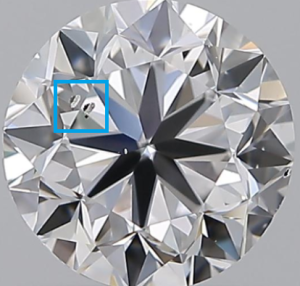Diamonds, nature’s glittering creations, are renowned for their sparkling allure. While they’re appreciated for their near-perfect transparency and radiant brilliance, the nuances that define each diamond are its inclusions, with one type being the cavity. As we delve deeper into this topic, we will unravel the intricate world of diamond inclusions, focusing specifically on cavities.

The Genesis of Inclusions
To appreciate the origin of cavities, we must first explore how diamonds are formed. These precious stones are created over billions of years under extreme temperature and pressure conditions deep within the Earth’s mantle. They are then propelled to the surface through explosive volcanic activity. As this tumultuous process unfolds, foreign materials often become trapped inside the crystallizing carbon structure. These trapped entities form the inclusions.
Cavity Inclusion: An Overview
Inclusions, like the cavity, can be considered tiny birthmarks, unique to each diamond. They contribute to the gem’s character, influencing aspects like clarity, color, and value. A cavity inclusion specifically refers to an opening or indentation on the diamond’s surface that reaches the interior, a miniature geological feature sculpted by nature itself.
How Cavity Inclusions are Formed
Cavities are typically formed during the diamond cutting and polishing process. When an internal inclusion is close to the diamond’s surface, it may be exposed or removed during polishing, leaving a small void or ‘cavity.’ They may also form naturally during a diamond’s journey to the surface, when a piece of the original crystal breaks off or a mineral inclusion disintegrates due to changes in temperature and pressure.
Identifying Cavities in Diamonds
Cavity inclusions can often be identified under 10x magnification, a standard in the gemological industry. These cavities may appear as tiny pits or indentations, possibly with an irregular shape or jagged edges. The size, number, and visibility of these cavities can vary, and some may only be visible under high magnification or to a trained gemologist.
The Impact of Cavities on Diamond Clarity
The presence of cavity inclusions can influence a diamond’s clarity grade, a critical factor in determining its value. If the cavities are large, numerous, or located in a conspicuous place, they may lower the diamond’s clarity grade, thus diminishing its overall value. However, minute cavities that are not easily noticeable to the naked eye may not significantly affect the diamond’s value or appearance.
Cavities and Diamond Care
While diamonds are the hardest known substance, they are not indestructible. Cavities may make a diamond more susceptible to damage if not handled with care. Cavities could potentially trap dirt or oils, which may impact the diamond’s brilliance. Thus, it’s crucial to clean diamond jewelry regularly and avoid harsh physical contact to preserve its beauty.
The Fascinating Aspect of Inclusions
Despite the potential downsides, inclusions, including cavities, have a positive aspect. They provide each diamond with a unique identity. No two diamonds are exactly alike, thanks to these natural imperfections. In some cases, inclusions such as cavities can even enhance a diamond’s appeal, especially for those who appreciate the individuality and history embedded in each gem.
The Unique Charm of Cavity Inclusions
Cavities are more than mere ‘flaws’ in a diamond. They are natural markers of a gemstone’s geological journey, an echo of the tumultuous processes that gave birth to these stunning stones. As with all inclusions, a cavity is a tiny testament to the diamond’s uniqueness, an imperfection that narrates a tale as old as time. Whether it’s a story of volcanic eruptions, immense pressure and heat, or the skilled hands of a diamond cutter, each cavity adds an intriguing layer to the diamond’s history, making it truly one-of-a-kind.
Indeed, understanding the nature of cavities and their influence on a diamond’s appearance and value can be a rewarding journey. It is a testament to the exquisite complexity of nature and the hidden beauty found even in imperfection.